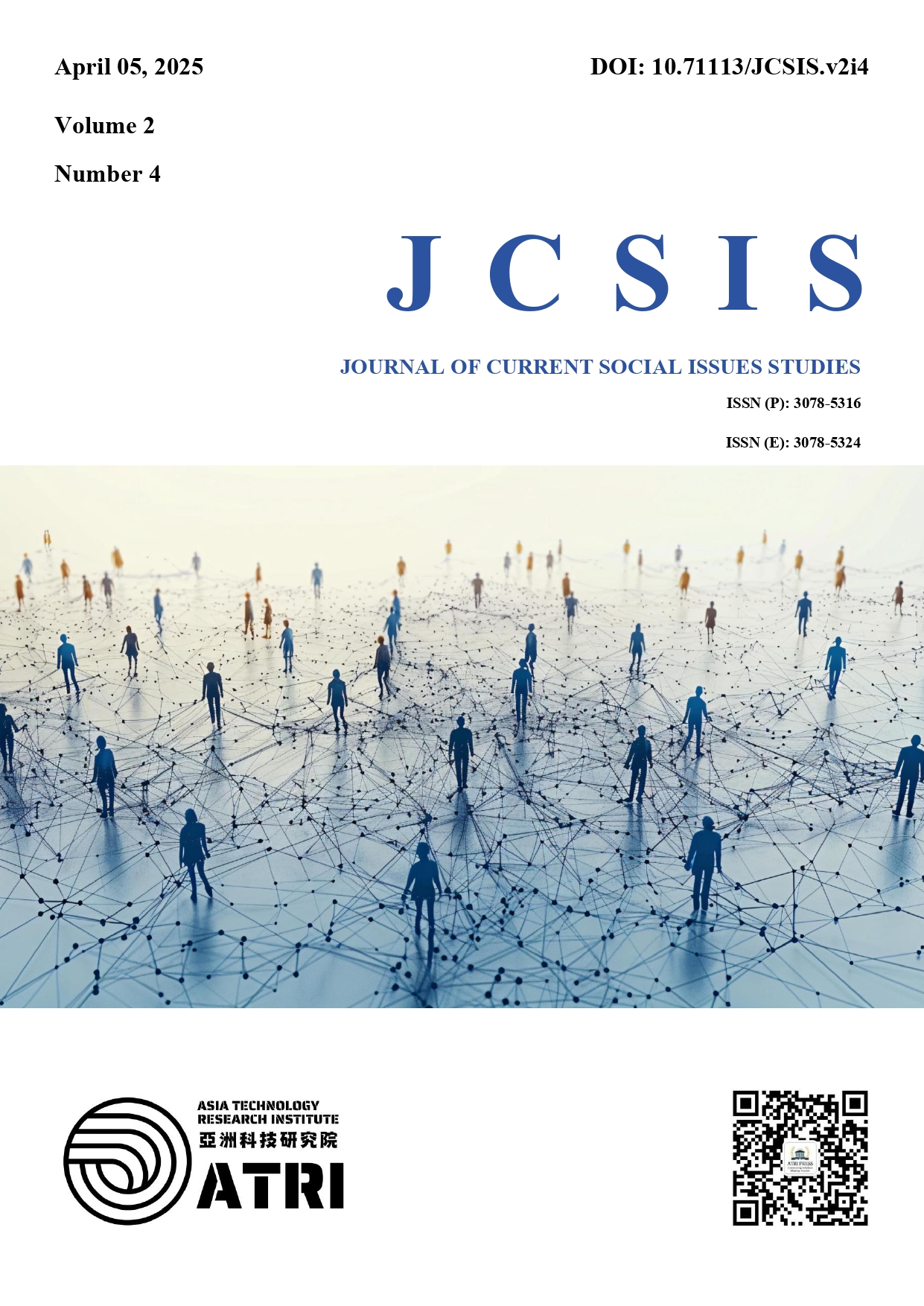The Ghostly Ethics of Mediatized Shaping: Cultural Memory and Creative Transformation of Anhui's ICH in Reviving the Craftsmanship
DOI:
https://doi.org/10.71113/JCSIS.v2i4.251Keywords:
Intangible Cultural Heritage (ICH), Mediatized Shaping, Cultural Memory, Creative Transformation, Ghostly Technology EthicAbstract
This study examines the creative transformation of intangible cultural heritage (ICH) in the digital age, focusing on the case of the Chinese TV program Reviving the Craftsmanship. By analyzing the show's practices through the dual lens of mediatized memory construction and techno-ethical negotiation, the research identifies three key mechanisms: super-visual encoding, cross-platform narratives, and ethical negotiations. Super-visual encoding transforms the embodied practices of ICH into spectacular visual symbols, enhancing the appeal of cultural memory while simultaneously leading to the "effacement of the body" of ICH's ontology. Cross-platform narratives leverage algorithmic logic to promote the fragmented dissemination of ICH, increasing public engagement but also commodifying it, resulting in fragmented memory and the demise of users' critical subjectivity. Ethical negotiations attempt to strike a balance between technological innovation and cultural preservation, utilizing concepts like the "ghostly contract" and the "mediatized ethical assessment matrix" to constrain the potential misuse of technology. This study constructs a critical theoretical framework of mediatized shaping, which reframes "creative transformation" as a tension-filled process and reveals the power relations and ethical dilemmas embedded within. Moving beyond the simplistic "protection/development" dichotomy, the research highlights the complexities of safeguarding and transmitting ICH in the digital era, and calls for a responsible and sustainable model of mediatized heritage transmission.
Downloads
References
[1]Anderson, B. (2006). Imagined communities: Reflections on the Origin and Spread of Nationalism. Verso. https://ci.nii.ac.jp/ncid/BA79169381
[2]Arvidsson, A. (2006). Brands: Meaning and Value in Media Culture. Routledge. https://ci.nii.ac.jp/ncid/BA75229029
[3]Baudrillard, J. (1994). Simulacra and simulation. University of Michigan Press. https://ci.nii.ac.jp/ncid/BA25132388
[4]Benjamin, W. (1968). The work of art in the age of mechanical reproduction. Harcourt, Brace & World. https://ci.nii.ac.jp/ncid/BA35437417
[5]Bucher, T. (2018). If . . . then: Algorithmic Power and Politics. Oxford University Press. https://ci.nii.ac.jp/ncid/BB27360019
[6]Couldry, N., & Hepp, A. (2017). The mediated construction of reality. Polity Press. https://ci.nii.ac.jp/ncid/BB23725772
[7]Debord, G. (2014). Society of the spectacle. Bureau of Public Secrets. https://ci.nii.ac.jp/ncid/BB24168875
[8]Derrida, J. (1994). Specters of Marx: The State of the Debt, the Work of Mourning, and the New International. Routledge. https://ci.nii.ac.jp/ncid/BA24120984
[9]Feenberg, A. (2002). Transforming technology: A Critical Theory Revisited. Oxford University Press. https://ci.nii.ac.jp/ncid/BA56065150
[10]Flusser, V. (2011). Into the universe of technical images. University of Minnesota Press. https://ci.nii.ac.jp/ncid/BB15250239
[11]Fuchs, C. (2024). Social media: A Critical Introduction. SAGE. https://ci.nii.ac.jp/ncid/BD10248471
[12]Giddens, A. (1991). Modernity and Self-Identity: Self and Society in the Late Modern Age. Stanford University Press. https://ci.nii.ac.jp/ncid/BA13386775
[13]Hepp, A. (2020). Deep mediatization. Routledge. https://ci.nii.ac.jp/ncid/BC17014482
[14]Kirshenblatt-Gimblett, B. (2004). Intangible Heritage as Metacultural production1. Museum International, 56(1–2), 52–65. https://doi.org/10.1111/j.1350-0775.2004.00458.x
[15]Latour, B. (2005). Reassembling the social: An Introduction to Actor-Network-Theory. Oxford University Press. https://ci.nii.ac.jp/ncid/BA73126910
[16]Lister, M., Dovey, J., Giddings, S., Grant, I., & Kelly, K. (2009). New media: A Critical Introduction. Routledge. https://ci.nii.ac.jp/ncid/BA89613182
[17]McLuhan, M. (2003). Understanding media: The Extensions of Man. Gingko Press. https://ci.nii.ac.jp/ncid/BA74026285
[18]Merleau-Ponty, M. (2002). Phenomenology of perception. Routledge. https://ci.nii.ac.jp/ncid/BA59644074
[19]Mirzoeff, N. (2011). The right to look: A Counterhistory of Visuality. Duke University Press. https://ci.nii.ac.jp/ncid/BC03228160
[20]Nissenbaum, H. (2010). Privacy in context: Technology, Policy, and the Integrity of Social Life. Stanford University Press. https://ci.nii.ac.jp/ncid/BB0057965X
[21]Poster, M. (1990). The mode of information: Poststructuralism and Social Context. University of Chicago Press. https://ci.nii.ac.jp/ncid/BA35483571
[22]Shusterman, R. (2012). Thinking through the body: Essays in Somaesthetics. Cambridge University Press. https://ci.nii.ac.jp/ncid/BB10334626
[23]Song, J. (Ed.). (2020). Annual Development Report on Chinese Intangible Cultural Heritage Safeguarding (2019). Social Sciences Academic Press. https://www.pishu.com.cn/skwx_ps/bookdetail?SiteID=14&ID=11711271
[24]Stiegler, B. (1998). Technics and Time, 1: The Fault of Epimetheus. Stanford University Press. https://ci.nii.ac.jp/ncid/BA37642698
[25]Stiegler, B. (2010). For a new critique of political economy. Polity. https://ci.nii.ac.jp/ncid/BB05111826
[26]Terranova, T. (2000). Free labor: Producing culture for the digital economy. Social Text, 18(2), 33–58. https://doi.org/10.1215/01642472-18-2_63-33
[27]Van Dijck, J. (2013). The culture of connectivity: A Critical History of Social Media. Oxford University Press. https://ci.nii.ac.jp/ncid/BB12479492
[28]Virilio, P. (1994). The Vision Machine. Indiana University Press. https://ci.nii.ac.jp/ncid/BA2402985X
[29]Winner, L. (2017). Do artifacts have politics? In Computer ethics (pp. 177–192). Routledge. https://doi.org/10.4324/9781315259697-21
[30]Žižek, S. (1989). The sublime object of ideology. Verso. https://ci.nii.ac.jp/ncid/BA81835486
[31]Zuboff, S. (2019). The age of surveillance capitalism: The fight for a human future at the new frontier of power. PublicAffairs. https://ci.nii.ac.jp/ncid/BC05506220
Downloads
Published
How to Cite
Issue
Section
License
Copyright (c) 2025 Ying Ma

This work is licensed under a Creative Commons Attribution 4.0 International License.























